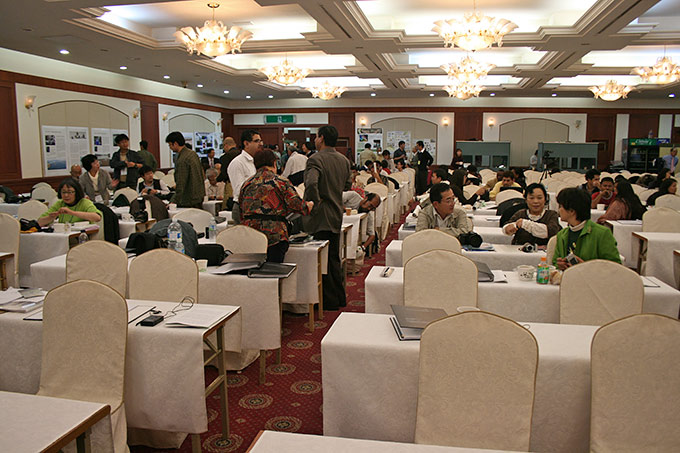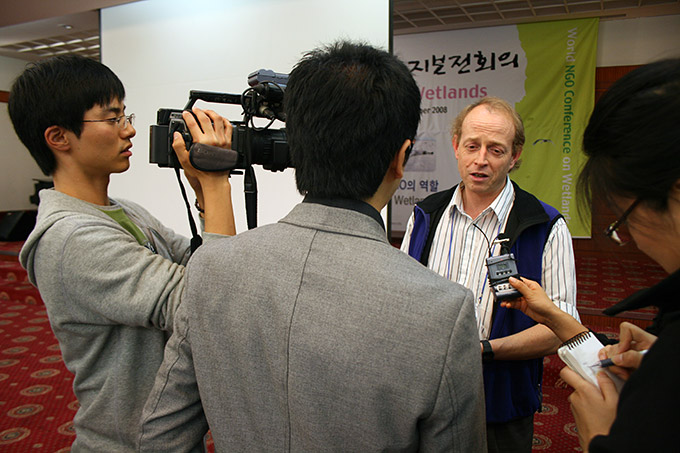The World NGO Conference on Wetlands was held in Suncheon City, Republic of Korea (ROK), over two days (October 26th and 27th). The aim of this meeting was to provide an opportunity for environmental NGOs to discuss issues facing wetlands and to develop and adopt an NGO declaration on the wise use of wetlands. This meeting was held prior to the 10th Conference of Contracting Parties of the Ramsar Convention (Changwon, October 28th-November 4th).
The first day saw a series of presentations grouped under the following themes:
Wise use of rice-paddy from the viewpoint of NGOs; Conservation of rice-paddy biodiversity and wise use;
Wise and unwise use of wetlands from the viewpoint of NGOs;
International NGO committee on Wetlands;
Adoption of an NGO statement on wetlands.

Dr Lew YOUNG, Ramsar’s Senior Regional Advisor for Asia-Oceania, made a key note speech about the role of NGOs in wetland conservation and the Ramsar Convention. Based on five broad objectives of the convention, Dr. YOUNG presented mechanisms for greater involvement of NGOs in wetlands management and conservation.
Non-Governmental Organisation’s can:
Wise use of wetlands
Provide an alternative national report to the Ramsar Secretariat alongside the one produced by their Government;
Review other countries’ policies to find best practice and then use these to lobby government for policy change;
Undertake surveying and monitoring of wetland sites.
Development of the list of internationally important wetlands
Identify potential Ramsar sites and lobby Government for listing these sites, while advising the Secretariat of the nomination.
International Cooperation
Continue organising meetings such as this World Congress.
Implementation of conservation
Draft CEPA action plans for their own programmes and involve local communities in management.
Membership in the Convention
Keep showing governments the benefit of joining Ramsar.
In summary, Dr. YOUNG advised NGOs to speak with one voice, base statements on fact and help link ecologists with sociologists to capture livelihood issues at wetland sites.
Mr PARK Jung Rok from Supchi wa seiduri chingu (Wetlands and Birds Korea) presented a series of current issues facing wetland management in the ROK. He also noted that the total area of Ramsar sites in the ROK, including the addition of three new Ramsar sites (which only added 48ha to the total), is extremely low when compared with other contracting parties.
Key components lacking in the ROK’s management of wetlands is an inventory on coastal wetlands, and the implementation of a Communications, Education and Public Awareness (CEPA) strategy. Mr PARK also highlighted that the Environment Impact Assessment (EIA) process in the ROK is conducted by non-independent consultants selected by developers. In addition, developments often proceed when an EIA has not been carried out.
He stressed that the current management arrangement for wetlands is confusing and disjointed. Coastal wetlands are managed by the Ministry of Land, Transport and Maritime Affairs, inland wetlands are managed by the Ministry of Environment and estuaries are under the management of both ministries. One ministry for all wetland types and habitats would make management more streamlined and help to improve communication and information sharing.
Birds Korea attended the first day of this Congress. Dr. Danny ROGERS from the Australasian Wader Studies Group (AWSG) made a presentation on the Saemangeum Shorebird Monitoring Program (SSMP) 2006 – 2008 on behalf of both organisations. The presentation was very well received and generated questions and discussion at the end of the session and during the break. Dr. ROGERS was subsequently interviewed about the SSMP by KFEM.

Photo © Birds Korea



